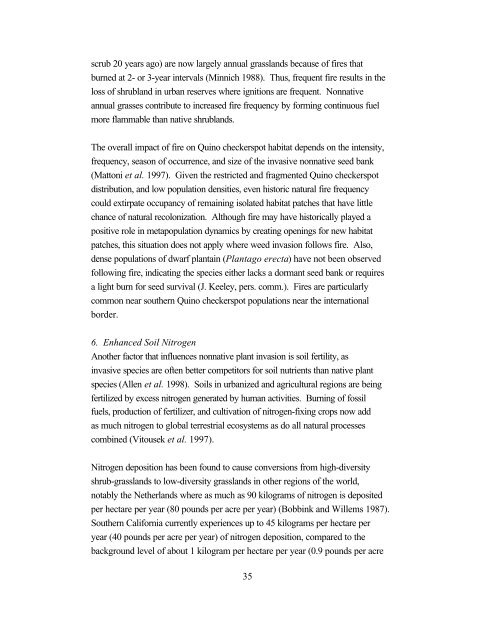Outline of Quino Recovery Plan - The Xerces Society
Outline of Quino Recovery Plan - The Xerces Society
Outline of Quino Recovery Plan - The Xerces Society
Create successful ePaper yourself
Turn your PDF publications into a flip-book with our unique Google optimized e-Paper software.
scrub 20 years ago) are now largely annual grasslands because <strong>of</strong> fires that<br />
burned at 2- or 3-year intervals (Minnich 1988). Thus, frequent fire results in the<br />
loss <strong>of</strong> shrubland in urban reserves where ignitions are frequent. Nonnative<br />
annual grasses contribute to increased fire frequency by forming continuous fuel<br />
more flammable than native shrublands.<br />
<strong>The</strong> overall impact <strong>of</strong> fire on <strong>Quino</strong> checkerspot habitat depends on the intensity,<br />
frequency, season <strong>of</strong> occurrence, and size <strong>of</strong> the invasive nonnative seed bank<br />
(Mattoni et al. 1997). Given the restricted and fragmented <strong>Quino</strong> checkerspot<br />
distribution, and low population densities, even historic natural fire frequency<br />
could extirpate occupancy <strong>of</strong> remaining isolated habitat patches that have little<br />
chance <strong>of</strong> natural recolonization. Although fire may have historically played a<br />
positive role in metapopulation dynamics by creating openings for new habitat<br />
patches, this situation does not apply where weed invasion follows fire. Also,<br />
dense populations <strong>of</strong> dwarf plantain (<strong>Plan</strong>tago erecta) have not been observed<br />
following fire, indicating the species either lacks a dormant seed bank or requires<br />
a light burn for seed survival (J. Keeley, pers. comm.). Fires are particularly<br />
common near southern <strong>Quino</strong> checkerspot populations near the international<br />
border.<br />
6. Enhanced Soil Nitrogen<br />
Another factor that influences nonnative plant invasion is soil fertility, as<br />
invasive species are <strong>of</strong>ten better competitors for soil nutrients than native plant<br />
species (Allen et al. 1998). Soils in urbanized and agricultural regions are being<br />
fertilized by excess nitrogen generated by human activities. Burning <strong>of</strong> fossil<br />
fuels, production <strong>of</strong> fertilizer, and cultivation <strong>of</strong> nitrogen-fixing crops now add<br />
as much nitrogen to global terrestrial ecosystems as do all natural processes<br />
combined (Vitousek et al. 1997).<br />
Nitrogen deposition has been found to cause conversions from high-diversity<br />
shrub-grasslands to low-diversity grasslands in other regions <strong>of</strong> the world,<br />
notably the Netherlands where as much as 90 kilograms <strong>of</strong> nitrogen is deposited<br />
per hectare per year (80 pounds per acre per year) (Bobbink and Willems 1987).<br />
Southern California currently experiences up to 45 kilograms per hectare per<br />
year (40 pounds per acre per year) <strong>of</strong> nitrogen deposition, compared to the<br />
background level <strong>of</strong> about 1 kilogram per hectare per year (0.9 pounds per acre<br />
35
















